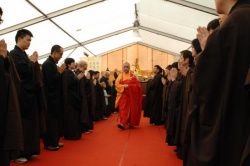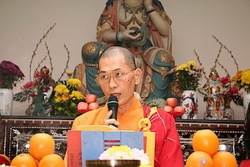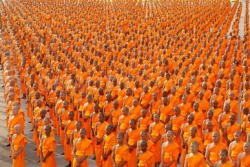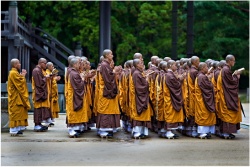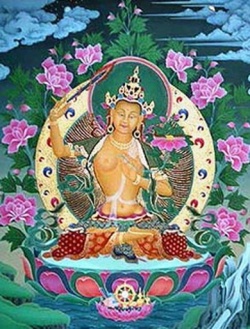Ajivika school
Ajivika school
アージービカ派・邪命外道 (Skt, Pali; Jpn Ajibika-ha or Jamyo-gedo)
A religious school in ancient India during Shakyamuni's time. The Ajivika school is said to have been as prosperous and influential as Buddhism and Jainism. It continued to flourish until the Maurya dynasty that began in the late fourth century B.C.E., and then it gradually declined. Ajivika was a name used disparagingly by Buddhists to mean one who performs religious practice in order to earn a living. The Sanskrit word ajiva means livelihood. In the Chinese translations of Buddhist scriptures, Ajivika is rendered as "the school of false livelihood." Makkhali Gosala, one of the six non-Buddhist teachers, was well known as the leader of the Ajivika school. The doctrine of this school is known only from descriptions found in Buddhist and Jain texts. The school held a completely deterministic and fatalistic view of the nature of existence, asserting that all events are predetermined by fate, and that the will and actions of human beings are totally ineffective in altering the course of their transmigration. Nevertheless, the followers of this school practiced asceticism as Jain followers did. The school existed in southern India until the fourteenth century.
Ājīvika (also written Ajivika or Ajivaka, literally "living" in Sanskrit) was a system of ancient Indian philosophy and an ascetic movement of the Mahajanapada period in the Indian subcontinent. Ājīvika was primarily a heterodox Hindu (Nāstika) system. The Ājīvikas may simply have been a more loosely-organized group of wandering ascetics (shramanas or sannyasins). One of their prominent leaders was Makkhali Gosala.
Ājīvika is thought to be contemporaneous to other early Hindu nāstika philosophical schools of thought, such as Cārvāka, Jainism and Buddhism, and may have preceded the latter two systems. While the early nāstika systems such as Cārvāka and Ājīvika gradually became extinct or evolved into others, the Jain and Buddhist traditions spun off into what may be described today as separate religions, distinct from Hinduism (which is now restrictively meant to encompass only the six orthodox Āstika philosophical systems).
Ājīvika reached the height of its popularity during the rule of the Mauryan emperor Bindusara around the 4th century BC. Several rock-cut caves belonging to this sect, built during the times of the Mauryan emperor Ashoka (r. 273 BC to 232 BC) have been found at Barabar Caves, Jehanabad district, Bihar.
Having being extinct for a long time, what information is known about the Ājīvika movement is primarily from historical references left behind in Jain and Buddhist sources, that may therefore be hostile to it. According to some of these sources, the Ājīvikas believed that a cycle of reincarnation of the soul was determined by a precise and non-personal cosmic principle called niyati (destiny or fate) that was completely independent of the person's actions. The same sources therefore make them out to be strict fatalists, who did not believe in karma.
More recent work by scholars suggests that the Ajivika were perhaps misrepresented by Jain and Buddhist sources.
[Johannes Bronkhorst's] claim is that, whereas the Jains teach that one can both stop the influx of new karma and rid oneself of old karma through ascetic practice, Gosāla taught that one could only stop the influx of new karma. [...] Ascetic practice can be effective in preventing further karmic influx, which helps to explain the otherwise inexplicable fact that the Ājīvikas did practice asceticism. [...] [T]he popularity of the Ājīvika doctrine in ancient times, such that it could rival that of both Jainism and Buddhism, also make sense if this doctrine was really not so radically different from these traditions as its presentation in Jain and Buddhist sources suggests.
Very little that is concrete is known about the Ājīvikas. Their scriptures and history were not preserved directly — instead, fragments of Ājīvika doctrine were preserved in Jain and Buddhist sources, and they are mentioned in several inscriptions from the Mauryan empire. As a result, it is unknown to what degree the available sources reflect the actual beliefs and practices of the Ājīvikas. Because most of what is known about them was recorded in the literature of rival groups, it is quite possible that accidental distortions or intentional criticism was introduced into the records. Even the name 'Ājīvika' itself may have only been assigned and used by observers from outside the tradition.
Some regard Makkhali Gosala (Pali; Sanskrit: Goshala Maskariputra) (c. 484 BCE) as the founder of the Ājīvika sect; other sources state that Gosala was only a leader of a large Ājīvika congregation of ascetics, but not the founder of the movement himself. Gosala is believed to have been a friend of Mahavira, the 24th Tirthankara of Jainism. The Jain Bhagavati Sutra depicts Gosala as having been a disciple of Mahavira's for a period of six years, after which the two had a falling out and parted ways. Purana Kassapa was another leader of the Ājīvikas.
According to the 2nd century CE text Ashokavadana, the Mauryan emperor Bindusara and his chief queen Subhadrângî, were a believer of this philosophy, that reached its peak of popularity during the same time, and then declined into obscurity. Ashokavadana also mentions that after his conversion to Buddhism, Bindusara's son Ashoka issued an order to kill all the Ajivikas in Pundravardhana, enraged at a picture that depicted Gautama Buddha in negative light. Around 18,000 followers of the Ajivika sect were executed as a result of this order. The Ājīvikas may have continued to exist in India until as late as the 13th Century CE, but the extent to which the tradition survived is unclear. Inscriptions from southern India make reference to the 'Ājīvikas' as late as the 13th Century CE, but by this point in history the term Ājīvika may have been used to refer to ascetics from other traditions rather than followers of the original Ājīvika tradition that existed during earlier centuries.
Biography of Makkhali Gosala
The father and mother of Gosāla were named, respectively, Mankhali and Bhaddā.
While Bhaddā was pregnant, she and her husband Mankhali, the mankha, came to the village ... of Saravaṇa, where dwelt a wealthy householder Gobahula. Mankhali left his wife and his luggage ... in Gobahula’s cowshed (gosālā) ... Since he could find no shelter elsewhere the couple continued to live in a corner of the cowshed, and it was there that Bhaddā gave birth her child."
Makkhali Gosala was originally a slave. However, he escaped: "he made off, but his master pursued and overtook him, by the edge of his robe", but he "escaped in a state of nudity." Makkhali Gosala was, together with Mahāvīra, at “a well ... recognized by two female followers of Pārśva". Makkhali Gosala reminded of the sesame plant which “had been pulled up, and had temporarily died, but it had been reanimated ... and was once more living, while the seven pods had developed”. Makkhali Gosala spoke of a company of merchants who found a large anthill, which had four heaps ... arising from its base. On breaking ... the second yielded gold”. An apparent “Gosāla ... declared that ... the original Gosāla was dead, and that the soul now inhabiting the apparent Gosāla was that of Udāï Kuṇḍiyāyaṇīya, ... taking up its abode in ... the dead Gosāla, which it had reanimated.”
Beliefs and practices
Along with the history of the Ajivika movement, the practices and beliefs of the Ajivikas are difficult to reconstruct, because they were only preserved in external, often hostile sources. Ajivikas seem to have been exponents of a philosophy of absolute determinism, in which human actions and choices are unable to overcome the forces of fate. Ajivika adherents followed a strict regimen of asceticism, similar in many ways to practices undertaken by the Jains — extreme fasting, indifference to physical discomfort and living exposed to the elements. Makkhala Gosala was often described as having lived without clothing, as are some other senior Ajivika adherents. It is not clear if all Ajivikas lived as naked wanderers, or if this was a practice that was only undertaken by the extremely devout. They were also strongly against the caste system and, much like their Jain and Buddhist counterparts, were mainly non-theistic. Ajivika leaders were sometimes depicted as ending their lives voluntarily when they felt that their bodies or minds were beginning to decline — either by fasting to death, or, in the case of Purana Kassapa, by drowning.
Ajivikas and Theism
Although most Ajivikas were atheistic there were many important theistic figures as well. Only Shiva and Vishnu however appear to be the gods of the Ajivikas. Bhattotpala, in 950 A.D. identified them with the "Ekandandins" (One-staff men writes that they are devotees of Narayana (Vishnu), although Shilanka speaking of the Ekandandins in another connection identifies them as Shaivas. Scholar James Hastings identifies the name "Mankhaliputta" or "Mankhali" with the bamboo staff. Scholar Jitendra N. Banerjea compares them to the Pasupatas Shaivas.
It is believed by scholar Charpentier that the Ajivikas before Makkhali Goshala worshiped Shiva.
Theology peculiar to the Ājīvikas
The "two divinities, Okkali and Ōkali, are mentioned as being responsible for the diffusion of the text [entitled "The Nine Rays"] among men." "The Tamil text Nīlakēci (Neelakesi) mentions two devas, Okkali and Ōkali, who according to the mythology of the Dravidian Ājīvikas, are said to have instructed men in the scriptures".
Metaphysics
"If all future occurrences are rigidly determined ..., coming events may in some sense be said to exist already. The future exists in the present, and both exist in the past. Time is thus on ultimate analysis illusory". "Every phase of a process is always present. ... in a soul which has attained salvation its earthly births are still present. Nothing is destroyed and nothing is produced. ... Not only are all things determined, but their change and development is a cosmic illusion."
"Life (jïva) cannot be cut or split, it is of eight parts".
Scriptures
The Ajivika are believed to have possessed a collection of scripture, based on references made to such a collection in Jaina sources. Of these scriptures, the only portions possibly surviving are scattered selections of verse in Buddhist and Jain sources that seem to represent quotations from the Ajivika scriptures. The Ajivika scriptures are not known to have ever been committed to writing, and their contents are unknown outside of these fragmentary quotations and a few hints provided by lists of titles recorded in non-Ajivika sources.
One such list collected by a Jaina commentator identifies the eight primary collections of texts as being grouped as follows:
Divyam (of the divine)
Autpātam (of portents)
Bhaumam (of the earth)
Āngam (of the body)
Svāram (of sound)
Lākşanam (of characteristics)
Vyāñjanam (of indications)
An alternative listing substitutes Suvine (dreams) for Divyam, and indicates that all of these collections were used for purposes of fortune telling, an activity in which Ajivika mendicants are described as engaging in several sources.
In addition to those eight scriptures, there were two more entitled as Magga-s. The two Magga-s (‘paths’, Skt. /mārgau/) are said by Abhayadeva to have been[22] those of song (“gīta”) and dance (“nṛtya”).
"The Ājīvika teacher in the Nīlakēci further gives the name of the [11th] scripture as ... “The Nine Rays” ...[which] is said to describe the atomic structure of the universe, and is one of the four cardinal points of the Ājīvika faith".
